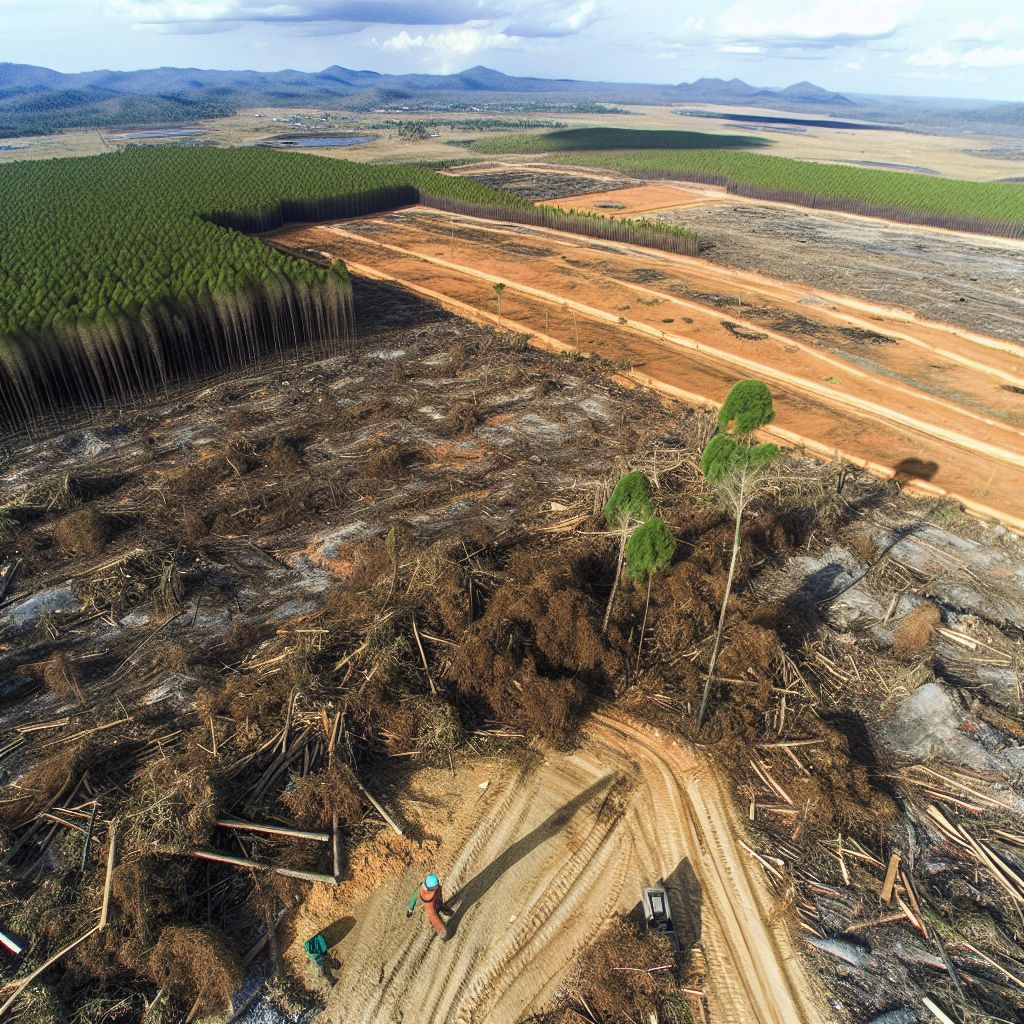Deutsch: Entwaldung / Español: deforestación / Português: desflorestação / Français: déforestation / Italiano: deforestazione
Deforestation in the industrial context refers to the large-scale removal of forests to make way for industrial activities such as mining, agriculture, and urban development. This process not only involves the physical clearing of forest lands but also encompasses the broader environmental, economic, and social implications associated with the expansion of industrial and commercial operations.
General Description

Deforestation driven by industrial demands is a significant environmental concern, as it leads to habitat destruction, biodiversity loss, and contributes to climate change through the release of stored carbon dioxide. Industries such as timber, palm oil, soy, and beef production are notable contributors to deforestation, especially in tropical regions. The conversion of forested areas into agricultural land, mining sites, and infrastructure development are among the primary industrial activities necessitating large-scale tree removal.
Application Areas and Well-Known Examples
- Agriculture: Large-scale farming operations, particularly for commodities like soy and palm oil, often result in the clearing of forests to expand cultivation areas.
- Mining: The extraction of minerals and resources, such as coal, gold, and bauxite, requires significant land clearing.
- Infrastructure Development: Construction of roads, dams, and urban expansion are key drivers of deforestation.
- Timber Industry: Logging for timber and paper production directly removes trees from forests.
Risks
Deforestation poses numerous risks, including loss of biodiversity, disruption of water cycles, soil erosion, and increased greenhouse gas emissions. These environmental changes have profound implications for climate change, local weather patterns, and the livelihoods of communities dependent on forest resources.
Treatment
Efforts to mitigate the impact of industrial-driven deforestation include promoting sustainable land management practices, reforestation and afforestation initiatives, and adopting stricter environmental regulations. Certification schemes, like the Forest Stewardship Council (FSC), aim to ensure that products are sourced from responsibly managed forests.
History and Legal Basics
The history of deforestation is intertwined with the expansion of human civilizations, but the industrial era marked a significant acceleration in forest loss due to increased Demand for agricultural and industrial commodities. Legal frameworks and international agreements, such as the United Nations Reducing Emissions from Deforestation and Forest Degradation (REDD+) program, have been developed to combat deforestation and encourage sustainable forest management.
Examples of Sentences
- "Industrial agriculture is a leading cause of deforestation in the Amazon basin."
- "Sustainable logging practices are essential to reduce the impact of the timber industry on deforestation."
- "Reforestation projects can help offset the carbon emissions associated with industrial deforestation."
Similar Terms or Synonyms
- Forest clearance
- Tree clearing
- Forest loss
Weblinks
- environment-database.eu: 'Deforestation' in the glossary of the environment-database.eu
- umweltdatenbank.de: 'Entwaldung' im Lexikon der umweltdatenbank.de (German)
Summary
In the industrial context, deforestation signifies the widespread clearing of forests to facilitate various industrial activities, posing significant environmental challenges. This process is driven by the demand for land for agriculture, resource extraction, and infrastructure development, leading to critical issues such as biodiversity loss and climate change. Addressing the impacts of deforestation requires concerted efforts towards sustainable development, including the adoption of environmentally friendly practices and legal measures aimed at protecting and restoring forest ecosystems.
--
Related Articles to the term 'Deforestation' | |
| 'Environmental Impact' | ■■■■■■■■■■ |
| Environmental Impact refers to the effect that human activities, especially those related to industry, . . . Read More | |
| 'Agriculture and farming' | ■ |
| Agriculture and farming in the industrial context refers to the large-scale cultivation of crops and . . . Read More | |
| 'Timber' | ■ |
| Timber is a term used to describe wood that has been processed into beams and planks, a stage in the . . . Read More | |
| 'Flue Gas Desulfurization' | ■ |
| Deutsch: Rauchgasentschwefelung / Español: Desulfuración de Gases de Combustión / Português: Dessulfurização . . . Read More | |
| 'Civilisation' | ■ |
| Civilisation in the context of industry refers to the stage of human social development and organization . . . Read More | |
| 'Sustainable industrial practice' | ■ |
| Sustainable industrial practice refers to the adoption of methods and processes in industrial operations . . . Read More | |
| 'Quartz' | ■ |
| Quartz in the industrial context refers to a versatile mineral composed primarily of silicon dioxide . . . Read More | |
| 'Fertilizer' | ■ |
| Fertilizer in the industrial context refers to any substance used to enhance the growth of plants by . . . Read More | |
| 'Green Manufacturing' | ■ |
| In the industrial and industry context, Green Manufacturing refers to the process of producing goods . . . Read More | |
| 'Agriculture industry' | ■ |
| Agriculture industry: The agriculture industry in the industrial context refers to the comprehensive . . . Read More | |
